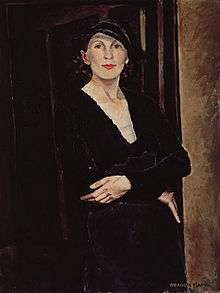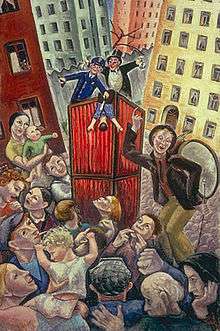Paraskeva Clark

Paraskeva Clark (October 28, 1898– August 10, 1986) was a Canadian painter born in St. Petersburg, Russia[1] and a member of the Canadian Group of Painters.
Early years
She was born Paraskeva Plistik, the daughter of Avdey Plistik and Olga Fedorevna, and, after finishing school, she worked as a clerk in a shoe factory and took evening classes at the Petrograd Academy of Fine Arts.[2] Prior to the October 1917 revolution she studied with Savely Seidenberg and at the Free Art Studios, which had previously been known as the Imperial Academy of Fine Arts, under Vasily Shukhayev and Kuzma Petrov-Vodkin (1918–1921).[3] In 1922, she married Oreste Allegri Jr., a scene painter, with whom she had a son; her husband drowned the following year.[2] From 1923, she lived in Paris with her son and then moved to Toronto, Canada in 1931 with her second husband,[3] Philip Clark, a Canadian accountant.[2]
Style
Her work is "carefully constructed and coloured".[3] and landscape paintings like The Pink Cloud of 1937 and the portraits, including the Self-portrait of 1933 "are equally rich in intricate formal relationships".[3] Such stylistic commentary reflects the influence of Petrov-Vodkin whose works themselves are "deceptively simple social-realist pictures with a similarly complex internal relationship of forms".[3]
Politics
Clark was introduced to Dr. Norman Bethune[3] in 1936 by Pegi Nicol MacLeod (1904–1949), art editor of the Canadian Forum from 1935-1936. From this point Clark became active in the Committee to Aid Spanish Democracy and not long after painted one of her most significant works: Petroushka in 1937.[3] Her work was to become one of the few politically influenced works to survive the era.
Petroushka

In Petroushka, Clark creates a seemingly innocent scene of street entertainers "to express her outrage at the recently reported brutal killing"[3] of five striking steelworkers by Chicago police in the summer of 1937. The painting was inspired by newspaper reports and she chose to adapt the story of Petrushka (the Peter puppet and symbol of suffering humanity within Russian tradition) to a North American context.
Clark felt passionately about the role and responsibility of the artist: "Those who give their lives, their knowledge and their time to social struggle have the right to expect great help from the artist. And I cannot imagine a more inspiring role than that which the artist is asked to play for the defence and advancement of civilization".[4]
Wartime duties and later life
She was appointed by the National Gallery of Canada to record the activities of the Women's Divisions of the Armed Forces during World War II and then later participated in many group shows between 1951 and 1956. She held four large solo shows comprising the University of Toronto (1952), two in 1956 at McGill University and Hart House, University of Toronto respectively and at the New Laing Gallery (1959). Her work is owned by many private collectors and the aforementioned institutions.[5] She was a member of the Royal Canadian Academy of Arts.[6]
Clark was the subject of a 1982 film by the National Film Board of Canada, Portrait of the Artist as an Old Lady.[1]
She died in Toronto at the age of 87.[1]
See also
Notes
- 1 2 3 McDougall, Anne. "Paraskeva Clark". The Canadian Encyclopedia.
- 1 2 3 "Paraskeva Clark". Celebrating Women's Achievements. Library and Archives Canada.
- 1 2 3 4 5 6 7 8 Reid, Dennis (1988). A Concise History of Canadian Painting. Toronto: Oxford University press. pp. 184–186. ISBN 0-19-540663-X.
- ↑ Newlands, Anne (2000). Canadian Art: From Its Beginnings To 2000. Firefly Books Ltd. p. 74. ISBN 978-1-55209-450-1.
- ↑ "Canadian Women Artists: Artist Database CLARK, Paraskeva". Retrieved 2009-05-03.
- ↑ "Members since 1880". Royal Canadian Academy of Arts. Retrieved 11 September 2013.
References
- Reid, Dennis (1988). A Concise History of Canadian Painting. Toronto: Oxford University press. pp. 184–186. ISBN 0-19-540663-X.
- Newlands, Anne (2000). Canadian Art: From Its Beginnings To 2000. Firefly Books Ltd. p. 74. ISBN 978-1-55209-450-1.
- Harper, J. Russell (1977). Painting in Canada: a history. University of Toronto Press. ISBN 0-8020-6307-1.
- "Canadian Women Artists: Artist Database CLARK, Paraskeva". Retrieved 2009-05-03.